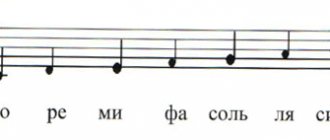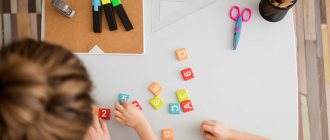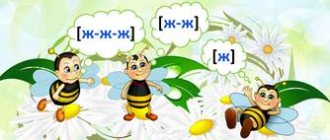Automation of sounds K and Kb
SOUND K. (No. 1)
1. Articulation gymnastics.
2. Automation of the sound [k] in syllables.
| ka-ko-ku-ky | ko-ku-ka-ka | ku-ky-ka-ko | ka-ka-ko-ku |
| ak-ok-uk-yk | ok-uk-yk-ak | uk-yk-ak-ok | yk-ak-ok-ku |
| ak-ak-ak-bak, poppy, so; | ok-ok-ok- current, side, juice, dock; | ||
| uk-uk-uk-knock, beech, grandson, spider; | yk-yk-yk- bull; | ||
| ik-ik-ik - peak, broom, date; | ek-ek-ek- century, running, snow; | ||
| yak-yak-yak- lighthouse, yak. | |||
3. Listen and repeat. Circle the droplets.
Rain, rain, have fun! Drip, drip, don't be sorry! Cap! Cap! Cap!…
4. Guess the word that
ends with the sound [k]: uro..., dru..., stu..., sapo..., then..., kri..., suro..., veni..., shnuro..., poro..., kato..., zamo..., wandered..., zna..., clo... , tres… .
5. Automation of the sound [k] in words.
Buck, poppy, so, flywheel, spider, turkey, knock, beech grandson, bull, side, dock, tobacco, stream, honey fungus, ration, broom, boot, oak, skein, hunter, hammer, tube, date, traveler, peak , yak, lighthouse, kayuk, dead end.
SOUND K. (No. 2)
1. Guess the riddle. Circle the answer.
We are green like grass Our song: “Kwa-kwa.”
2. Guess the word, starting it with the sound [k], [k']:
...okos, ...ist, ...ino, ...niga, ...oshka, ...it, ...mouth, ...ring, ...ex, ...oldun, ...ofe, ...ost, ...amen, ...well done, ...orova.
3. Automation of the sound [k] in syllables.
| Kwa-kwo-kwu-kwa | kna-kno-knu-kny |
| Kwo-kwo-kwo-kwo | kno-knu-kny-kna |
| Kwu-kwa-kwa-kwo | knu-kny-kna-kno |
| Kwa-kwa-kwo-kwo | kny-kna-kno-knu |
4. The names of which pictures sound similar?
5. Game "Fun Score". Count the ducks.
SOUND K. (No. 5)
1. Repeat pure sayings.
| ka - ka - ka - our burden is not light; | The ball of thread rolled into the corner. |
| ko - ko - ko - ran away far; | Klava put the onion on the shelf, |
| ku - ku - ku - we buy flour. | Nikolka called to her. |
2. Game "One-many".
| Boar - wild boars | cabin - cabins, | stone - stones, |
| ditch - ditches, | trap - traps, | horse - horses, |
| cat - cats, | rope - ropes, | comet - comets, |
| candy - candy, | team - teams, | room - rooms. |
3. Game "Hide and Seek". Name the pictures.
4. Repeat pure sayings.
| On the coconuts, on the coconuts | There are seven kittens on the bench |
| We swooped in like wasps, | All kittens want to eat. |
| And the coconuts are high | We will pour jelly into a bowl - |
| High and far away.* | Here's a bowl of jelly for you. |
SOUND K. (No. 6)
1. Guess the riddle. Circle the answer.
| They fly without wings, they run without legs, | |
| They sail without a sail. (clouds) |
2. Game "One-many".
| One tank – many tanks | one letter - many letters |
| One poppy - many poppies | one pumpkin - many pumpkins |
| One beech – many beeches | one window - many windows |
| One spider - many spiders | one lighthouse – many lighthouses |
| One bull - many bulls | one turkey - many turkeys |
| One oak - many oaks | one broom – many brooms |
3. Repeat the phrase.
| Pussy, pussy, where's your bowl? | |
| Pussy eats soup from a bowl: | |
| Full pussy - empty bowl. | |
| (Lay out from counting sticks) |
4. Automation of the sound [k] in word combinations.
meow under the window; bathe horses in the Oka; dig a ditch; buy a lump; smoke perch.
5. Game "Hide and Seek". Name the pictures.
SOUND K. (No. 7)
1. Game "Correct the mistake."
| A letter is written to grandfather. | Our mouse caught the cat. |
| My grandmother bought a spool of thread. | The pebble found Pasha. |
| A coat hanger is hung on the fur coat. | Reeds sit in a frog. |
| The lilies of the valley found Natasha. | They put a bag inside the potatoes. |
2. Game "Funny Counting".
3. Automation of the sound [k] in words.
How, cockatoo, cocoa, what, rim, trap, croak, cot, kok, cocoon, lump, penny, button, cube, cup, purchase, picnic, horse, duck.
SOUND K. (No. 1)
1. Automation of the sound [k'] in syllables.
| kya-kya - kya-kya-kya | kya-ke-kyu-ki |
| ke-ke - ke-ke-ke | ke-kyu-ki-kya |
| kyu-kyu - kyu-kyu-kyu | kyu-ki-kya-ke |
| ki-ki - ki-ki-ki | ki-kya-ke-kyu |
2. Automation of the sound [k'] in words.
Kiwi, nod, cinema, Kim, kippa, skates, cubes, poppies, cap, cap, buoy, whale, boiling water, boots, Nikita, bouquet, package, ocean, hemp, sneakers, descendants.
3. Automation of the sound [k'] in phrases.
buy poppies; wear a cap and sneakers; nod to Nikita; put on a cape; drink boiling water; cubes in a bag; Nikitin's boots; go to the cinema.
4. Repeat pure sayings.
| There is a whale in the ocean, boiling water for the whale. | We buy items: |
| Svetka buys a cap with a label. | For Nikita those purchases |
| And for Kim those purchases. | |
| And in shopping ducks, pipes, | |
| Cubes and forget-me-nots. |
5. Game “What’s missing?” (hands, paws, legs).
Summary of a speech therapy lesson on the topic: Sounds [k][k], letter “K”
Summary of a group speech therapy lesson. 2nd grade.
Topic: Sounds [k], [k`], letter K.
Goal: correctly and clearly pronounce the sounds k, k` in syllables, words and sentences.
Tasks:
Educational:
· Strengthen the skills of distinguishing and clearly pronunciating the sounds k, k` in syllables, words and sentences;
· Develop skills in forming singular and plural nouns;
· Strengthen the ability to coordinate nouns with adjectives in gender and number.
Educational:
· Develop articulatory motor skills;
· Correction and development of fine motor skills of the hands by performing specially selected exercises (imitation of playing snowballs and tracing along lines);
· Promote the development and correction of attention, memory, thinking.
Educational:
· Develop self-control over speech, the ability to listen attentively to the speech of a speech therapist.
· Promote a caring attitude towards school supplies.
Equipment: presentation, task cards, subject pictures, ball, stickers, mirrors.
Progress of the lesson.
1. Organizational moment.
- The one who names a word consisting of 3 syllables will sit down.
2. Report the topic of the lesson.
- Today we will get acquainted with sounds and letters, guess the riddle and you will find out what we are talking about.
He doesn't sleep at all at night,
Keeps the house safe from mice,
Drinks milk from a bowl
Well, of course it’s ... (cat)
— Today a kitten named Kitty came to visit us for class.
— Divide the word kitten into syllables
- what is the 1st syllable? (ko), first and last sound? (k, j).
3. Characteristics of the sounds [k], [k`] according to articulatory and acoustic characteristics.
- Take a mirror and pronounce the sound [k].
— How do you pronounce the sound [k] (put the tongue behind the lower teeth, move it slightly back, the back of the tongue bends, then exhale the air sharply).
— How does the air flow occur? (free or encounters an obstacle).
- Let’s use our palms to check whether our voice is sleeping or singing? (sleeping).
Conclusion: When the consonant sound [k] is pronounced, the air stream encounters an obstacle.
- Name the 1st and 2nd sounds in the word kitten (k and o), o-vowel of the 1st row
— Guys, if after the consonants there are vowels of the 1st row, then our consonants are hard.
- Bend your fingers and repeat after me, what sound is [k]?
- The sound [k] is consonant, deaf, hard (the speech therapist speaks for the 1st time, together for the 2nd time, and the students alone for the 3rd time).
— We denote the hard consonant sound [k] with a blue circle.
- Now name the first syllable in the word Kiti (ki)
- first sound (k), second (i)
- And - what row is the vowel? (2 rows).
- If after a consonant there is a vowel of the 2nd row, then the consonant will be soft. Those. in the syllable ke the sound [k`] is soft.
-So the sound [k] is consonant, deaf, soft (the speech therapist speaks for the 1st time, together for the 2nd time, and the students alone for the 3rd time).
— We denote the soft consonant sound [k`] with a green circle.
4. Development of phonemic awareness.
-Let's play the game "Catch the Sound." I will pronounce sounds, syllables and words, if you hear the sound [k], then clap your hands.
-K, m, k, ko, ly, ta, ia, stake, garden, cat, dream.
- And now we catch the soft sound [k]:
- K, p, z, cinema, k, sa, mu, ki, k
- Well done boys.
-We hear and speak sounds, but we write letters. To read or write the names of objects, we need to become familiar with the letter. We denote the sounds k and k by the letter K.
— Now I’ll read a poem about the letter K.
Look at the letter K:
There is a leg and there is a hand.
Kostya shouted to the cat: “Shoo!”
It's all in K, baby.
- Let's raise our hands and write the letter K in the air with our fingers. And now with our eyes.
- Find objects in the class whose names contain the sounds k-k`.
5. Reading syllables.
ko kya
ka kyo
ky kyu
ku ki
- We read the syllables of the 1st row, in all these syllables what is the sound? (hard), why? (after k - there are vowels of the 1st row)
- What circle will we use? (blue)
- We read the syllables of the 2nd row, in all these syllables what is the sound? (soft), why? (after k- there are vowels of the 2nd row)
- What circle will we use? (green)
— Recording syllables in pairs under dictation.
- What syllables were written in the 1st column, what vowels come after k (vowels of the 1st row), i.e. We will underline the consonant letter k with a blue circle.
- What syllables were written in the 2nd column, what vowels come after k (vowels of the 2nd row), i.e. We will underline the consonant letter k with a green circle.
6. Pronunciation of sounds k - k` in words.
— Our kitten Kitty hid the pictures around the classroom.
- What is this? (card, balls, textbook, suit, pencils, skittles).
— Name the picture, he’s my only one (suit, textbook)
- She is my only one (card)
- They are mine (pencils, balls, skittles)
- Find a word that has one syllable (no)
- Two syllables (suit, skittles)
— Three syllables (balls, card, textbook,)
Reading these words on a card (one at a time) syllable by syllable, eyes closed, repeated again, write from memory in the first column with a small letter without commas.
- How the sound k sounds in these words (firmly), we underline with a blue pencil.
- Name a word in which the sound k is at the beginning of the word, what sound?
- Name a word that has 2 syllables and 6 sounds
— Guys, how to handle school supplies. (you can’t tear, write, or dirty textbooks; keep pens and pencils in a pencil case, don’t break them)
— Also, toys must be handled with care (you cannot tear, break, throw, get dirty and must be stored in special drawers and shelves).
7. Physical exercise
Game "One - Many".
Toy - toys
Machine - cars
Road - roads
Cube – cubes
- Which sound sounded in the words I studied, and which in your words?
Light bulbs - light bulb
bears - bear
rulers – ruler
textbooks - textbook
- Which sound sounded in the words I studied, and which in your words?
8.Look at the board and read the words, which vowels are missing
Slippery slide
Cool sank.
Beautiful roads.
- We need to make friends between the words of the 1st and 2nd columns.
- Write this phrase in your notebook.
— In which word does the sound k sound hard (underline hard k-blue, soft k- with green pencil).
9. Summary of the lesson and assessment of the child’s activities.
- Our lesson is over. What sounds did we learn to pronounce correctly today? What letter do we use on the letter? Well done! SLIDE
·
Causes
To understand how to set the sound correctly, you need to know the root cause of the deviation from the norm. The occurrence of erroneous or complete absence of pronunciation of the sound “K” and “K” is influenced by the following factors:
- Organic defects associated with abnormal structure of the speech organs:
- abnormalities of the upper part of the oral cavity. The palate may be too high, soft, narrow. The soft part is hard and vice versa.
- the baby’s inability to distinguish sounds by ear (phonemic deviations);
- weak tongue muscles;
- poor sensitivity of the tongue muscles;
- mild physical hearing impairment.
- Social factors:
- omission of parents, educators, teachers;
- use of 2 or more languages in the family;
- lack of articulation exercises;
- repeating speech with errors for loved ones.
- A specialist can determine what factor predisposes the child to develop a defect and how to eliminate it. To do this, the speech therapist collects a detailed medical history on an individual basis, examines the condition of the speech organs and draws a conclusion based on the examination.
Dividing soft sign
The role of the soft sign in the Russian language
So, the soft sign does not mean and has absolutely no sound. The role of this letter in the Russian language is different: it is an indicator of the softness of consonant sounds in writing, and also performs a separating function. The topic “Dividing soft sign” is taught in the subject Russian language in 2nd grade.
Soft sign - an indicator of the softness and form of the word
The soft sign is used in writing to soften the previous consonant sound. If we hear a soft consonant sound in the middle or at the end of a word, then in writing in this place after the soft consonant we should write a soft sign: icicle, eight, bathhouse, stranded.
Also, a soft sign is written after the hissing words at the end of some words to indicate a specific dictionary form. For example, in the word mouse, a soft sign indicates that this is a noun, in the feminine form, III declension. And in the word guard, the soft sign indicates the indefinite form of the verb.
Dividing soft sign
As a dividing sign, a soft sign is used in writing to separate a consonant letter and the letters E, E, Yu, I, I. This is necessary to distinguish words that are similar to each other. For example, in pairs of words: seed - family, plaque - pour, Kolya - stakes, it is the soft sign that indicates which word is in front of us.
The soft separating sign is also written in some words of foreign origin: champignon, broth, pavilion. The spelling of such words should be memorized.
Rules for writing words with a soft sign
A soft sign is never written at the absolute beginning of a word or after a prefix.
If a soft sign is used to indicate the form of a word (night, see, go), then it is written after the consonant at the end of the word.
As an indicator of softness, b is written after the letter denoting a soft consonant sound: letter, money, dictionary.
Games with letters and words
“Games with letters and words” is a fun journey into the world of the Russian language! With the help of funny poems and illustrations, children will learn about upper and lowercase letters, ambiguous words, the rules of hyphenation, and also solve riddles and laugh along with the heroes of this smart and funny book!
Buy
Rules for writing words with a soft separator
- The separating soft sign is written in the middle of the word before the vowels E, E, Yu, Ya, I: blizzard, sew, brothers.
- The separating b is written in some words of foreign origin before the letter O: battalion, postman, pavilion.
- The separating soft sign is written after the consonants in the roots of words: September, nightingales, daughter.
It is convenient to work with the topic of spelling using the textbook “Russian Language. 4th grade".
Methodological advice for teachers
In order for students to better remember new information, it is recommended to use visual material. The basic rules are formulated concisely and logically, structures in the form of diagrams and tables allow you to quickly navigate the provisions and norms.
To help the teacher, we offer two tables with rules for the Russian language on the topics:
- "The role of soft language"
- "Dividing hard and soft signs."
What else should I read?
Preparation for the VPR-2019 in the Russian language. Word formation
Working with text in preparation for VLOOKUP
Systematic preparation for CPR in the Russian language in 4th grade
Features of preparation for the Russian language test in 4th grade
Tasks to reinforce the topic
To consolidate or repeat the topic “Dividing soft sign” in 2nd grade, you can use not only standard exercises on the missing letter, but also add interesting task-games to the workshop.
"Two Columns"
Assignment: divide the words into two columns, write words in the first column where b is used as an indicator of softness, and in the second column write words where b is a separator. Give your own examples of words with a soft separator.
Words: friends, elk, hare, peasant, trees, pain, family, frog, serious, primer, blizzard, benefit, fox, shreds, laziness.
Answer:
| b - softness | Separating b |
| elk | Friends |
| pain | hare |
| primer | peasant |
| benefit | trees |
| laziness | family |
| froglike | |
| serious | |
| snowstorm | |
| shreds |
"Add a word"
Exercise:
complete the sentence using words with a soft sign; Explain in which words there is a separating b, and in which there is an indicator of softness. The resulting words can be written in the corresponding columns in the table from the previous task.
Offers:
- Mom, dad, I am happy...
- After the cockfight in the yard there were...
- The weather outside today is bad - everything is... going...
- The hawk spread...
- The hunter charged his...
- Yesterday our cat caught...
- Zhenya and Vova are best friends...
- The owl is hunting...
- Katya went to the store and... forgot at home
- There was loud chirping on the street...
Answers:
- Mom, dad and I are a happy family .
- After a cockfight there were feathers .
- The weather outside today is bad - it has been raining day .
- The hawk spread its wings .
- The hunter loaded his gun .
- Yesterday our cat caught a mouse .
- Zhenya and Vova are bosom friends .
- The owl hunts at night .
- Katya went to the store, but the money at home.
- Sparrows were chirping loudly on the street .
Words with a soft separator: family, feathers, wings, gun, friends, at night, sparrows.
Words where b is a sign of softness : day, rain, mouse, money.
“Earrings for all sisters”
Task: transform phrases like “cat fur - cat hair.” For convenience, you can write words in a table, where the first column will contain these phrases, and the second column will contain the new ones.
Collocations:
- fox fur coat
- pack of wolf
- fish roe
- croaking frogs
- antler
- bear's den
- sheep wool
- bunny ears
- goat milk
- crow cawing
Answers:
- fox coat
- Wolf Pack
- fish roe
- frog croak
- deer horns
- Bear Den
- sheep's wool
- bunny ears
- goat milk
- crow cawing
Visual materials for the lesson
Using a soft sign
The role of the soft sign
Dividing soft sign
Spelling b and b in words
"Create a last name"
Assignment: form surnames from given names. For convenience, you can write words in a table, where the first column will contain names, and the second column will contain the resulting surnames.
Names: Gregory. Evgeny, Yuri, Vasily, Arseny, Afanasy, Macarius, Arkady, Anatoly.
Answers:
| Names | Surnames |
| Gregory | Grigoriev |
| Eugene | Evgeniev |
| Yuri | Yuryev |
| Basil | Vasiliev |
| Arseny | Arsenyev |
| Afanasy | Afanasiev |
| Macarius | Makariev |
| Arkady | Arkadyev |
| Anatoly | Anatolyev |
#ADVERTISING_INSERT#







